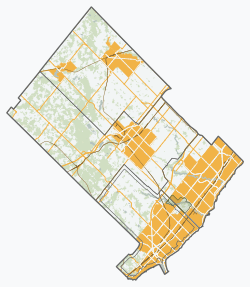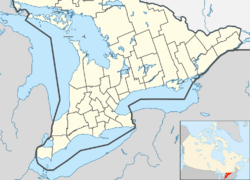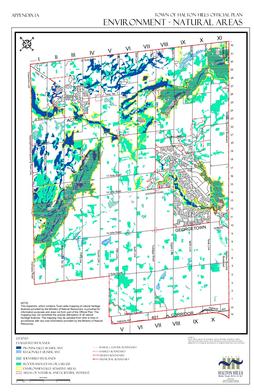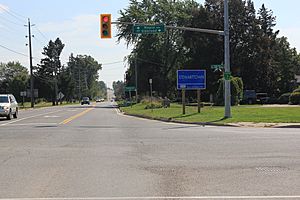Halton Hills facts for kids
Quick facts for kids
Halton Hills
|
|||
|---|---|---|---|
| Town of Halton Hills | |||

Main Street, Georgetown
|
|||
|
|||
| Motto(s):
Hereditas Integritas Veritas (Latin: Heritage, integrity, truth)
|
|||
| Country | Canada | ||
| Province | Ontario | ||
| Region | Halton | ||
| Incorporated | 1974 | ||
| Area | |||
| • Land | 276.26 km2 (106.66 sq mi) | ||
| • Urban | 39.52 km2 (15.26 sq mi) | ||
| • Rural | 236.74 km2 (91.41 sq mi) | ||
| Highest elevation | 411 m (1,348 ft) | ||
| Lowest elevation | 197 m (646 ft) | ||
| Population
(2016)
|
|||
| • Town (lower-tier) | 61,161 | ||
| • Density | 221.4/km2 (573/sq mi) | ||
| • Urban | 49,854 | ||
| • Urban density | 1,261.49/km2 (3,267.2/sq mi) | ||
| • Rural | 9,154 | ||
| • Rural density | 38.6669/km2 (100.147/sq mi) | ||
| Time zone | UTC−05:00 (EST) | ||
| • Summer (DST) | UTC−04:00 (EDT) | ||
| Area code(s) | 905, 289, and 365 | ||
| NTS Map | 30M12 Brampton | ||
| GNBC Code | FBLIE | ||
Halton Hills is a town in the Regional Municipality of Halton, located in the northwestern end of the Greater Toronto Area, Ontario, Canada with a population of 62,951 (2021).
There are many natural features within these bounds; they include the Niagara Escarpment, and the Bruce Trail. Many of these local features are protected by the Conservation Halton, Credit Valley Conservation & Grand River Conservation Authority.
Contents
Communities
The primary population centres are Georgetown and Acton. Additionally, there are a number of hamlets and rural clusters within the town, including Ashgrove, Ballinafad (straddling the boundary with Erin), Bannockburn, Crewsons Corners (straddling the boundary with Erin, Guelph-Eramosa and Milton), Glen Williams, Henderson's Corners, Hornby, Limehouse, Mansewood, Norval, Scotch Block, Silver Creek, Speyside, Stewarttown, Terra Cotta (straddling the boundary with Caledon), and Wildwood. The area was first settled in the 1820s.
Geography
| Black Creek | |
| River | |
| Basin | 79.28 km² (31 sq mi) |
|---|---|
| Discharge | for 43°37′45″N 80°0′37″W / 43.62917°N 80.01028°W |
| - average | 0.231 m³/s (8 cu ft/s) |
| - max | 0.353 m³/s (12 cu ft/s) |
| - min | 0.142 m³/s (5 cu ft/s) |
| Credit River, West Branch | |
| River | |
| Basin | 127.00 km² (49 sq mi) |
|---|---|
| Discharge | for 43°38′47″N 79°51′58″W / 43.64639°N 79.86611°W |
| - average | 1.33 m³/s (47 cu ft/s) |
| - max | 2.06 m³/s (73 cu ft/s) |
| - min | 0.683 m³/s (24 cu ft/s) |
The town is bisected by the Niagara Escarpment from southwest to northeast, and a significant portion of the rural area is located within the provincial Greenbelt. Above the Escarpment, a large proportion of the rural area is classified as environmentally sensitive wetlands, and there are several sites that are licensed for aggregate extraction, for which expansion requires detailed environmental assessment. Below the Escarpment, the rural area is mainly agricultural, with the exception of an industrial area currently being development between Highway 401 and Steeles Avenue.
The town also forms part of three watersheds:
-
- to the west of Acton, a small area flows toward the Grand River
- the northern half flows into the Credit River, including the Black Creek and Silver Creek tributaries
- the southern half flows into the Sixteen Mile Creek
The Water Survey of Canada operates two hydrometric monitoring stations in the town, on the Black Creek below Acton, and at Norval on the Credit River.
Vegetation
Halton Hills is located in the transition zone between the Huron-Ontario Forest Section of the Great Lakes-St. Lawrence forest zone to the north and the Niagara Section of the Carolinian forest zone to the south. Both forest zones are part of the Mixedwood Plains Ecozone. The natural vegetation in the Huron-Ontario Section is dominated by mixed wood forests. It is a transitional type between the southern deciduous forests and the northern coniferous forests. The forest communities of the Niagara Section are dominated by broad-leaved trees. Overall, Halton Hills consists predominantly of agricultural lands with scattered woodlands and wetlands. The woodlands are mainly deciduous forest and the wetlands are either cedar swamp or cattail marsh.
Endangered and threatened species
American ginseng exists in the town, and is protected under the Endangered Species Act, 2007. Butternut trees are also threatened by the butternut canker. The hooded warbler and the Jefferson salamander are also designated as threatened species.
Brook trout had been eliminated from the Black Creek watershed for many years, following an environmental disaster south of Acton in March 1946. The trout have since returned, and anglers report that fishing is good.
Geology
The physiography and distribution of surface material in the Town of Halton Hills are the result of glacial activity which took place in the Late Wisconsinan Substage of the Pleistocene Epoch. This period of time, which lasted from approximately 23,000 to 10,000 years ago, was marked by the repeated advance and melting back of massive, continental ice sheets.
The Niagara Escarpment dominates the physiography of the town and greatly influenced the pattern of glaciation in the region. The Escarpment, formed by erosion over millions of years, is a high relief bedrock scarp which trends to the north through the central part of the town. To the west, on the upper surface of the Escarpment, hummocky morainic ridges deposited by glacial ice form part of the Horseshoe Moraines physiographic region. To the southeast below the Escarpment, is a smooth glacial till plain partially bevelled by lacustrine action, which forms part of the South Slope and Peel Plain physiographic regions.
The Town of Halton Hills is underlain by Ordovician shales of the Queenston Formation east of the Niagara Escarpment, and by Silurian dolostones of the Amabel Formation west of the Escarpment. The escarpment face exposes a complex succession of shales, sandstones, limestones and dolostones of the Clinton and Cataract Groups. Red shales of the Queenston Formation underlie the eastern half of the town and are generally covered by more than 15 m of glacial sediments, predominantly the Halton Till. There are several areas of thin drift cover south of Georgetown.
The quarrying of limestone has been undertaken since the 19th century, and the lime industry was once quite prevalent. In 1886, the Toronto Lime Company had operations in Limehouse and Acton, employing a total of four draw kilns and eleven set kilns, producing common lime and water lime. At Limehouse, rock from the Clinton formation yielded green and brown shales and blue marl, which were used in the manufacture of mineral paints.
Small oil and gas deposits have been discovered northwest and south of Acton, and around Hornby. While exploration had occurred as early as 1908, with oil being discovered in 1912, significant strikes did not occur until 1954.
The town is located in an area that is considered to be of low seismic potential, and the largest recent earthquake to take place within its limits was of magnitude 3 on 29 June 1955. There is a POLARIS seismic monitoring station located just west of Acton.
Climate
Halton Hills has a humid continental climate (Köppen climate classification Dfb).
The Town has two distinct climate zones:
- Zone 5a - north of the Niagara Escarpment
- Zone 5b - south of the Escarpment
Environment Canada operates one climate monitoring station at Georgetown.
| Climate data for Georgetown WWTP (Halton Hills), 1981−2010 | |||||||||||||
|---|---|---|---|---|---|---|---|---|---|---|---|---|---|
| Month | Jan | Feb | Mar | Apr | May | Jun | Jul | Aug | Sep | Oct | Nov | Dec | Year |
| Record high °C (°F) | 17.0 (62.6) |
15.5 (59.9) |
25.0 (77.0) |
31.5 (88.7) |
34.5 (94.1) |
36.0 (96.8) |
37.0 (98.6) |
36.5 (97.7) |
35.5 (95.9) |
29.5 (85.1) |
22.0 (71.6) |
20.5 (68.9) |
37.0 (98.6) |
| Mean daily maximum °C (°F) | −1.7 (28.9) |
−0.2 (31.6) |
4.6 (40.3) |
12.1 (53.8) |
19.1 (66.4) |
24.4 (75.9) |
26.9 (80.4) |
25.8 (78.4) |
21.4 (70.5) |
14.3 (57.7) |
7.3 (45.1) |
1.1 (34.0) |
12.9 (55.2) |
| Daily mean °C (°F) | −6.3 (20.7) |
−5.2 (22.6) |
−0.9 (30.4) |
6.0 (42.8) |
12.3 (54.1) |
17.4 (63.3) |
20.0 (68.0) |
19.0 (66.2) |
14.8 (58.6) |
8.4 (47.1) |
2.8 (37.0) |
−2.9 (26.8) |
7.1 (44.8) |
| Mean daily minimum °C (°F) | −10.9 (12.4) |
−10.2 (13.6) |
−6.4 (20.5) |
−0.2 (31.6) |
5.3 (41.5) |
10.4 (50.7) |
13.0 (55.4) |
12.1 (53.8) |
8.1 (46.6) |
2.4 (36.3) |
−1.7 (28.9) |
−6.9 (19.6) |
1.3 (34.3) |
| Record low °C (°F) | −33.0 (−27.4) |
−31.5 (−24.7) |
−28.0 (−18.4) |
−13.0 (8.6) |
−5.0 (23.0) |
−0.5 (31.1) |
3.0 (37.4) |
0.0 (32.0) |
−4.0 (24.8) |
−8.5 (16.7) |
−15.5 (4.1) |
−29.5 (−21.1) |
−33.0 (−27.4) |
| Average precipitation mm (inches) | 67.8 (2.67) |
60.0 (2.36) |
57.2 (2.25) |
76.5 (3.01) |
79.3 (3.12) |
74.8 (2.94) |
73.5 (2.89) |
79.3 (3.12) |
86.2 (3.39) |
68.3 (2.69) |
88.5 (3.48) |
65.9 (2.59) |
877.4 (34.54) |
| Average rainfall mm (inches) | 29.7 (1.17) |
28.4 (1.12) |
35.2 (1.39) |
71.3 (2.81) |
79.0 (3.11) |
74.8 (2.94) |
73.5 (2.89) |
79.3 (3.12) |
86.2 (3.39) |
67.8 (2.67) |
79.9 (3.15) |
36.4 (1.43) |
741.5 (29.19) |
| Average snowfall cm (inches) | 38.1 (15.0) |
31.7 (12.5) |
22.1 (8.7) |
5.2 (2.0) |
0.3 (0.1) |
0.0 (0.0) |
0.0 (0.0) |
0.0 (0.0) |
0.0 (0.0) |
0.5 (0.2) |
8.6 (3.4) |
29.5 (11.6) |
135.9 (53.5) |
| Average precipitation days (≥ 0.2 mm) | 12.6 | 9.4 | 10.6 | 12.4 | 11.9 | 11.2 | 10.6 | 10.6 | 11.7 | 12.3 | 13.3 | 12.3 | 138.9 |
| Average rainy days (≥ 0.2 mm) | 4.1 | 4.1 | 6.4 | 11.6 | 11.8 | 11.2 | 10.6 | 10.6 | 11.7 | 12.2 | 11.4 | 6.5 | 112.1 |
| Average snowy days (≥ 0.2 cm) | 9.4 | 6.2 | 4.8 | 1.4 | 0.04 | 0.0 | 0.0 | 0.0 | 0.0 | 0.27 | 2.5 | 6.9 | 31.5 |
| Source: Environment Canada | |||||||||||||
History
Halton Hills was established in 1974 through the amalgamation of the former Towns of Georgetown and Acton, together with much of the former Township of Esquesing, and a small portion of the Town of Oakville lying north of Ontario Highway 401.
On August 1, 2013, Toronto Premium Outlets, the first Premium Outlets Centre in Canada, opened for business.
Demographics
| Halton Hills | ||
|---|---|---|
| Year | Pop. | ±% |
| 1981 | 35,190 | — |
| 1991 | 36,816 | +4.6% |
| 1996 | 42,390 | +15.1% |
| 2001 | 48,184 | +13.7% |
| 2006 | 55,289 | +14.7% |
| 2011 | 59,008 | +6.7% |
| 2016 | 61,161 | +3.6% |
| 2021 | 62,951 | +2.9% |
| Canada census – Halton Hills community profile | |||
|---|---|---|---|
| 2016 | 2011 | 2006 | |
| Population: | 61,161 (3.6% from 2011) | 59,008 (6.7% from 2006) | 55,289 (14.7% from 2001) |
| Land area: | 276.27 km2 (106.67 sq mi) | 276.25 km2 (106.66 sq mi) | 276.26 km2 (106.66 sq mi) |
| Population density: | 221.4/km2 (573/sq mi) | 213.6/km2 (553/sq mi) | 200.1/km2 (518/sq mi) |
| Median age: | 41.3 (M: 40.5, F: 42.0) | 39.9 (M: 39.3, F: 40.4) | 37.9 (M: 37.5, F: 38.2) |
| Total private dwellings: | 21,080 | 20,548 | 19,265 |
| Median household income: | $106,349 | $94,190 | $85,520 |
| References: 2016 2011 2006 earlier | |||
| Group | 2021 Census | 2016 Census | 2011 Census | 2006 Census | |||||
|---|---|---|---|---|---|---|---|---|---|
| Population | % of total | Population | % of Total | Population | % of Total | Population | % of Total | ||
| Canadian citizen | By birth | 50,245 | 80.6 | 50,310 | 83.6 | No data | 46,380 | 84.3 | |
| By naturalization | 9,685 | 15.6 | 8,120 | 13.5 | 6,845 | 12.4 | |||
| Permanent resident | 2,150 | 3.4 | 1,630 | 2.7 | 1,515 | 2.8 | |||
| Non-permanent resident | 245 | 0.4 | 140 | 0.2 | 280 | 0.5 | |||
| Total | 62,325 | 100.0 | 60,200 | 100.0 | 55,020 | 100.0 | |||
| Group | 2021 Census | 2016 Census | 2011 Census | 2006 Census | |||||
|---|---|---|---|---|---|---|---|---|---|
| Population | % of total | Population | % of Total | Population | % of Total | Population | % of Total | ||
| Indigenous | First Nations | 1,200 | 1.1 | 635 | 1.1 | No data | 480 | 0.9 | |
| Métis | 445 | 0.7 | 390 | 0.6 | |||||
| Visible Minority | 8,450 | 13.6 | 4,475 | 7.4 | 2,235 | 4.0 | |||
| All other | 52,730 | 84.6 | 54,700 | 90.9 | 52,305 | 95.1 | |||
| Total | 62,325 | 100.0 | 60,200 | 100.0 | 55,020 | 100.0 | |||
In 2021, Halton Hills was 84.6% white/European, 13.6% visible minorities, and 1.8% Indigenous. The largest visible minority groups were South Asian (5.6%), Black (1.7%), Chinese (1.2%), Filipino (1.0%) and Latin American (1.0%).
80.8% of residents spoke English as their mother tongue. The next most common first languages were Polish (1.7%), Portuguese (1.6%), French (1.5%), Punjabi (1.4%), Croatian (1.2%), Italian (1.0%) and Spanish (1.0%). 2.2% of residents listed both English and a non-official language as mother tongues, while 0.5% listed both English and French.
61.4% of the population were Christian, down from 72.1% in 2011. 34.3% were Catholic, 16.8% were Protestant, 6.2% were Christian n.o.s, 1.6% were Christian Orthodox and 2.6% belonged to other Christian denominations or Christian-related traditions. 32.2% were non-religious or secular, up from 26.3% in 2011. 6.4% belonged to other religions, up from 1.6% in 2011.The largest non-Christian religions were Islam (2.0%), Sikhism (1.9%), and Hinduism (1.5%).
| Group | 2021 Census | 2016 Census | 2011 Census | 2006 Census | 2001 Census | 1996 Census | ||||||
|---|---|---|---|---|---|---|---|---|---|---|---|---|
| Population | % of total | Population | % of Total | Population | % of Total | Population | % of Total | Population | % of Total | Population | % of Total | |
| At the same address | 41,290 | 69.5 | 38,745 | 67.8 | 37,510 | 68.6 | 30,270 | 58.9 | 25,135 | 56.4 | 22,370 | 57.4 |
| In the same municipality | 5,350 | 9.0 | 8,125 | 14.2 | 7,460 | 13.6 | 8,480 | 16.5 | 17,540 | 39.3 | 7,175 | 18.4 |
| In the same province | 11,515 | 19.3 | 9,190 | 16.1 | 8,625 | 15.8 | 11,180 | 21.7 | 8,285 | 21.2 | ||
| From another province | 480 | 0.8 | 435 | 0.8 | 520 | 1.0 | 765 | 1.5 | 1,920 | 4.3 | 735 | 1.9 |
| From another country | 815 | 1.4 | 655 | 1.1 | 525 | 1.0 | 720 | 1.4 | 430 | 1.1 | ||
| Total aged 5 or over | 59,450 | 100.0 | 57,150 | 100.0 | 54,640 | 100.0 | 51,420 | 100.0 | 44,595 | 100.0 | 39,000 | 100.0 |
Transportation
The town has four main roads:
East-west
 Highway 7 connecting Acton and Georgetown
Highway 7 connecting Acton and Georgetown- Regional Road 8 (Steeles Avenue) between Milton and Brampton
North-south
- Regional Road 25 between Acton and Milton
- Regional Road 3 (Trafalgar Road) between Ballinafad and Oakville
Bus service is provided by GO Transit along Highway 7 on its Georgetown line corridor. Via Rail and GO Train service are provided at Georgetown GO Station.
The Grand Trunk Railway brought train service to the area in 1856, with stations at Acton and Georgetown. Passenger service to Acton ceased in the 1990s, but GO Train service is planned to be revived there in 2013.
Rail freight service is also provided by Canadian National on its Halton Subdivision from Georgetown southwest through Milton to Burlington. CN's Guelph Subdivision between Georgetown and London is currently managed by Goderich–Exeter Railway.
In November 2020, VIA Rail Canada rerouted some of its trains onto the Halton Subdivision through Stewarttown while their usual route was closed for signal upgrades.
From 1917 to 1931, Norval, Georgetown and Acton were also served by the Toronto Suburban Railway.
Schools
| Type | Halton District School Board | Halton Catholic District School Board | Independent |
|---|---|---|---|
| Secondary school |
|
|
|
| Primary school |
|
|
|
Media
HaltonHillsToday.ca is an online local news source in Halton Hills, offering the latest breaking news, weather updates, entertainment, sports and business features, obituaries and more.
Halton Hills is also covered by the following local newspapers and online media:
- Georgetown Independent
- Acton Free Press
- The Acton New Tanner
- The Halton Compass
- Halton Herald
- In Georgetown Community Website
A radio transmitter in Hornby is used by stations CFZM and CJBC.
Sister cities
Halton Hills has one sister city:
- Wenjiang (Chengdu), Sichuan, China








